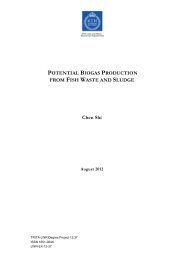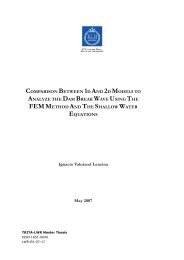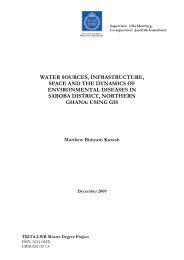radon in groundwater - Mark- och vattenteknik - KTH
radon in groundwater - Mark- och vattenteknik - KTH
radon in groundwater - Mark- och vattenteknik - KTH
- No tags were found...
You also want an ePaper? Increase the reach of your titles
YUMPU automatically turns print PDFs into web optimized ePapers that Google loves.
Kirlna Skeppström TRITA LWR.LIC 2032Detailed study on LjusteröThe results of the detailed study are presented<strong>in</strong> Fig.7. The observed concentrationof 222 Rn <strong>in</strong> <strong>groundwater</strong> tended to <strong>in</strong>creasewith <strong>in</strong>creas<strong>in</strong>g concentration of uranium(total U) and radium ( 226 Ra) <strong>in</strong> the solution.However, the correlations were weak, 0.16and 0.18 for 238 U and 226 Ra respectively. Thisobservation supports the concept that <strong>radon</strong>concentration <strong>in</strong> <strong>groundwater</strong> pr<strong>in</strong>cipallycomes from its parent elements ( 238 U and226 Ra) deposited on the surfaces of fractures(Åkerblom and L<strong>in</strong>dgren, 1997). Regard<strong>in</strong>gground measurements of equivalent uranium(eU) made directly on outcrops, it could beobserved that high <strong>radon</strong> concentrationscould occur <strong>in</strong> bedrock of low to moderateuranium content. It was also observed thatthe <strong>radon</strong> concentration <strong>in</strong> <strong>groundwater</strong> didnot <strong>in</strong>crease with <strong>in</strong>creas<strong>in</strong>g content of uranium<strong>in</strong> the bedrock. The same observationwas made for the analysis of 222 Rn <strong>in</strong><strong>groundwater</strong> and airborne uranium measurements.These observations could beexpla<strong>in</strong>ed by the fact that the bedrock identifiedby visual <strong>in</strong>spection above the groundsurface might not be the same <strong>in</strong> the subsurfacewhere <strong>groundwater</strong> is extracted. Anotherplausible argument relates to the migrationof radionuclides (ma<strong>in</strong>ly 226 Ra and238 U) <strong>in</strong> <strong>groundwater</strong> flow. The bedrockmight orig<strong>in</strong>ally conta<strong>in</strong> low concentrationsof act<strong>in</strong>ide but transportation of 238 U and226 Ra can contribute to <strong>in</strong>creas<strong>in</strong>g the <strong>radon</strong>concentration <strong>in</strong> the <strong>groundwater</strong>. The localconditions are difficult to identify <strong>in</strong> reality.The activity ratio of 226 Ra/ 238 U <strong>in</strong> solutionvaried between 0 and 12, which clearly <strong>in</strong>dicatesa state of disequilibrium <strong>in</strong> the<strong>groundwater</strong> system.(a)(b)(c)Fig. 7: (a) Relationship between 222 Rn anduranium <strong>in</strong> <strong>groundwater</strong>; (b) Relationshipbetween 222 Rn and radium <strong>in</strong> <strong>groundwater</strong>;(c) Relationship between 222 Rn <strong>in</strong> <strong>groundwater</strong>and measured uranium <strong>in</strong> bedrock outcrops.18
















